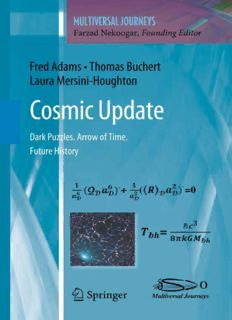
Cosmic Update: Dark Puzzles. Arrow of Time. Future History PDF
Preview Cosmic Update: Dark Puzzles. Arrow of Time. Future History
Cosmic Update MultiversalJourneys FoundingEditor: FarzadNekoogar,President MultiversalJourneys EditorialAdvisoryBoard: DavidFinkelstein,GeorgiaInstituteofTechnology LawrenceM.Krauss,ArizonaStateUniversity MarkTrodden,UniversityofPennsylvania Forfurthervolumes: http://www.springer.com/series/7919 Fred Adams (cid:2) Thomas Buchert Laura Mersini-Houghton Farzad Nekoogar Founding Editor Cosmic Update Dark Puzzles. Arrow of Time. Future History 123 FredAdams ThomasBuchert DepartmentofPhysics Universite´Lyon1 RandallLaboratory CentredeRechercheAstrophysiquedeLyon UniversityofMichigan CNRSUMR5574 ChurchStreet450 9avenueCharlesAndre´ 49109-1040AnnArbor F-69230Saint-Genis-Laval Michigan France USA [email protected] [email protected] LauraMersini-Houghton DepartmentofPhysicsandAstronomy UniversityofNorthCarolina ChapelHillNorthCarolina USA [email protected] FoundingEditor FarzadNekoogar MultiversalJourneys 17328VenturaBlvd. Encino,CA91316 USA [email protected] ThearticlebyLawrenceM.KraussandRobertJ.Scherrerisreproducedbypermissionofits copyrightowner. Multiversal JourneysTM is a trademark of Farzad Nekoogar and Multiversal Journeys, a 501(c)(3)nonprofitorganization ISBN978-1-4419-8293-3 e-ISBN978-1-4419-8294-0 DOI10.1007/978-1-4419-8294-0 SpringerNewYorkDordrechtHeidelbergLondon LibraryofCongressControlNumber:2011934680 (cid:3)c SpringerScience+BusinessMedia,LLC2012 Allrightsreserved.Thisworkmaynotbetranslatedorcopiedinwholeorinpartwithoutthewritten permission of the publisher (Springer Science+Business Media, LLC, 233 Spring Street, New York, NY10013, USA),except forbrief excerpts inconnection with reviews orscholarly analysis. Usein connectionwithanyformofinformationstorageandretrieval,electronicadaptation,computersoftware, orbysimilarordissimilarmethodologynowknownorhereafterdevelopedisforbidden. Theuseinthispublicationoftradenames,trademarks,servicemarks,andsimilarterms,eveniftheyare notidentifiedassuch,isnottobetakenasanexpressionofopinionastowhetherornottheyaresubject toproprietaryrights. Printedonacid-freepaper SpringerispartofSpringerScience+BusinessMedia(www.springer.com) To MyParents Farzad Preface Outfornoreasonthisuniversecametobe Outofaplacetobe,thisuniversefilleditself Rumi 1207–1273 Many cultures throughout the history including the Greeks, ancient Egyptians, Indians, Chinese, and Persians fascinated by the night sky studied stars and the heavens for centuries. However, the study of the cosmos in the form of classical scientific astronomy using mathematical descriptions is traced back to early seventh century AD. From seventh to fourteenth century, Persian mathe- maticians and astronomers Kharazmi (780–850), Biruni (973–1048), Khayyam (1048–1131),Tusi(1201–1274),andKashani(1380–1429)eachcontributedalotto thefieldofastronomy.Theircontributionswerefurtherdevelopedandimprovedby EuropeanastronomersCopernicus(1473–1543),Galileo(1564–1642),andKepler (1571–1630)overthenextthreecenturies.SirIsaacNewton’stheoryofgravitation revolutionizedastronomicalcalculationsbylatesixteenthcentury(in1687,Newton published his Principia). Newtonian mechanics made it possible to formulate the motionofallcelestialbodiesinthesolarsystemandbeyond. New discoveries and theories within the last century have drastically changed our understanding of the cosmos. With the advent of Einstein’s General Theory of Relativity and the observational discovery on the expansion of the Universe by Slipher, as well as Hubble’s discovery of Hubble’s law (indicating that far galaxies are receding from us) as early as 1920s, cosmology became a much more distinct science than astronomy. In 1922, Alexander Friedmann’s solutions to Einstein’s equations formulated the evolution of a relativistic expanding or contracting dynamic Universe. The more advanced models are now known as Friedmann–Lemaitre–Robertson–Walker (FLRW) models of cosmology due to manyenhancementsandcontributionsfromothercosmologists. From 1930s onward, the Big Bang theory formed the basis for explaining the expansion of the Universe. However, the original Big Bang theory endured three problems, namely, the smoothness problem, the horizon problem, and the vii viii Preface flatness problem. The first problem asks why the matter is uniformly distributed in the Universe. The second problem concerns the large-scale uniformity of the observable Universe. Finally, the third problem asks why the Universe is close to being spatially flat. With the introductionof the InflationaryModelof cosmology in 1980s by Alan Guth, the three problems of the Big Bang cosmological model weresolved.Accordingtoinflationarycosmology,thesizeoftheUniverseexpanded exponentiallytoanextremelyhugenumber(1060/ofitsoriginalsize.Thishappened inaveryshorttimefrom10(cid:4)35to10(cid:4)32saftertheBigBang.Collectively,theBig BangmodelandInflationModelsofcosmologydescribedtheoriginandexpansion oftheUniverse. By the mid-1990s, new observations led to new models of cosmology. The modernStandardModelofCosmology,whichisgenerallyacceptedamongcosmol- ogists,integratesthefollowingtheories,models,andconcepts:afixedbackground space-time, the General Theory of Relativity, Dark Matter, Dark Energy, initial conditionsat Big Bang (best described by InflationaryModels), and the Standard Model of particle physics. Although the Standard Model of Cosmology has its own outstandingproblemssuch as Dark Matter and Dark Energy,and issues with inflation,yetitexplainsalltheobservations. Todaycosmologistsworkwithsomeofthemostintriguingandyetfundamental questionssuchas: (cid:129) WhatistheoverallshapeandsizeoftheUniverse? (cid:129) WhydidtheUniversestartinanimprobablestate? (cid:129) Didinflationhappen? (cid:129) Isthereamultiverse? (cid:129) WhatistheultimatefateoftheUniverse? (cid:129) WhatisthetruenatureofDarkEnergy? (cid:129) CanphysicsdescribewhatwashappeningbeforetheBigBang? (cid:129) WhathappenstothenotionsofspaceandtimebeforetheBigBang? Currently there is no single theory that successfully answers all of the above questions. Beyond the Standard Model of cosmology, speculative theories in quantumgravity are used to researchsolutionsfor the problemof the selectionof initialconditionsoftheUniverse. Thepurposeofthisbookistopresentandexplainthefollowinguniquetopicsin moderncosmology: (cid:129) AnovelapproachtouncoverthedarkfacesoftheStandardModelofcosmology. (cid:129) The possibility that Dark Energy and Dark Matter are manifestations of the inhomogeneousgeometryofourUniverse. (cid:129) On the history of cosmological model building and the general architecture of cosmologicalmodels. (cid:129) Illustrationsofthelarge-scalestructureoftheUniverse. (cid:129) AnewperspectiveontheclassicalstaticEinsteinCosmos. (cid:129) GlobalpropertiesofWorldModelsincludingtheirtopology. (cid:129) ThearrowoftimeinaUniversewithapositivecosmologicalconstant (cid:2). Preface ix (cid:129) Exploringthe consequencesof a fundamentalcosmologicalconstant (cid:2) for our Universe. (cid:129) ExploringwhythecurrentobservedaccelerationoftheUniversemaynotbeits finaldestiny. (cid:129) Demonstratingthatnatureforbidstheexistenceofapurecosmologicalconstant. (cid:129) Ourcurrentunderstandingofthelongterm(intimescalesthatgreatlyexceedthe currentageoftheUniverse)futureoftheUniverse. (cid:129) The long-term fate and eventual destruction of the astrophysical objects that populate the Universe – including clusters, galaxies, stars, planets, and black holes. (cid:129) All evidence of the Big Bang including the Cosmic Microwave Background (CMB), and of the existence of other galaxies outside our own will disappear inabout100billionyears. The materialis presented in a layperson-friendlylanguagefollowed by additional technicalsectionsthatexplainthebasicequationsandprinciples.Thisfeatureisvery attractivetoreaderswhowanttolearnmoreaboutthetheoriesinvolvedbeyondthe basicdescription. Each chapter is self-contained. Chapter 3 and Appendix A are related and collectivelydescribethefutureoftheUniverse. Chapter1discussesa newperspectiveontheconceptofDarkMatterandDark Energy. The conventional view on Dark Matter is that these are particles that respond to the gravitational force, but they do not respond to strong, weak, and electromagneticforces.Wesimplyjusthavenotdiscoveredthemyet.Whetherthey will be produced in the near future with LHC experiments at CERN, or detected withotherexperimentssuchastheCryogenicDarkMatterSearch(CDMS),remains to be seen. The nature of Dark Energy, however, is more mysterious than that of Dark Matter. It is believed to be the vacuum energy with negative pressure in its simplestformthatcausesthe Universeto accelerate.Itaccountsforabout75%of thematter/energyoftheUniverse. Chapter1arguesthattheStandardModelofcosmologymaybejusttoosimple, sinceitassumesthattheUniverseasawholecanbedescribedbythehomogeneous solutions of Einstein’s equations. The chapter recalls the historical development of the Standard Model of cosmology and illustrates modern developmentsof our understanding of the large-scale structure of the Universe. It explains the short- comingsoftheStandardModelanddevelopsamoregeneralmodelofcosmology that takes into account the inhomogeneities in the matter distribution, but also in the geometryof space-time. The tight relations between this geometryand global propertiesofourUniverse,asimpliedbyafullapplicationoftheGeneralTheoryof Relativity,providepossiblesolutionstotheDarkEnergyandDarkMatterproblems. Inthisnewframework,theclassicalUniversemodel,favoredbyEinstein,isputinto perspectiveand, using this example, the limits and possible generalizationsof the StandardCosmologicalPrinciplearediscussed. Chapter 2 investigates the Arrow of Time in a Universe with a positive cos- mologicalconstant (cid:2). On the observedacceleration of our Universe, the analysis
Description: